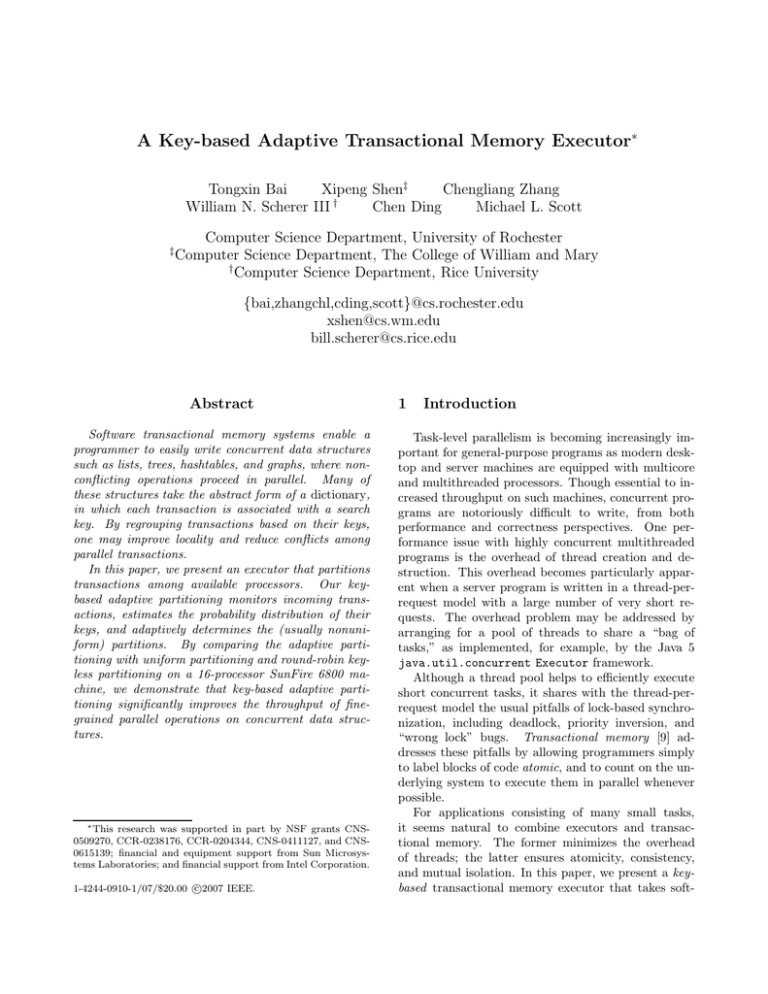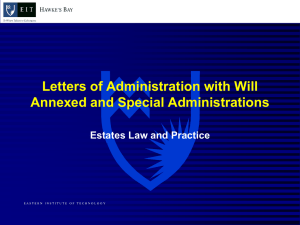A Key-based Adaptive Transactional Memory Executor
advertisement

A Key-based Adaptive Transactional Memory Executor∗
Tongxin Bai
Xipeng Shen‡
Chengliang Zhang
†
Chen Ding
Michael L. Scott
William N. Scherer III
‡
Computer Science Department, University of Rochester
Computer Science Department, The College of William and Mary
†
Computer Science Department, Rice University
{bai,zhangchl,cding,scott}@cs.rochester.edu
xshen@cs.wm.edu
bill.scherer@cs.rice.edu
Abstract
Software transactional memory systems enable a
programmer to easily write concurrent data structures
such as lists, trees, hashtables, and graphs, where nonconflicting operations proceed in parallel. Many of
these structures take the abstract form of a dictionary,
in which each transaction is associated with a search
key. By regrouping transactions based on their keys,
one may improve locality and reduce conflicts among
parallel transactions.
In this paper, we present an executor that partitions
transactions among available processors. Our keybased adaptive partitioning monitors incoming transactions, estimates the probability distribution of their
keys, and adaptively determines the (usually nonuniform) partitions. By comparing the adaptive partitioning with uniform partitioning and round-robin keyless partitioning on a 16-processor SunFire 6800 machine, we demonstrate that key-based adaptive partitioning significantly improves the throughput of finegrained parallel operations on concurrent data structures.
∗ This research was supported in part by NSF grants CNS0509270, CCR-0238176, CCR-0204344, CNS-0411127, and CNS0615139; financial and equipment support from Sun Microsystems Laboratories; and financial support from Intel Corporation.
c
1-4244-0910-1/07/$20.00 2007
IEEE.
1
Introduction
Task-level parallelism is becoming increasingly important for general-purpose programs as modern desktop and server machines are equipped with multicore
and multithreaded processors. Though essential to increased throughput on such machines, concurrent programs are notoriously difficult to write, from both
performance and correctness perspectives. One performance issue with highly concurrent multithreaded
programs is the overhead of thread creation and destruction. This overhead becomes particularly apparent when a server program is written in a thread-perrequest model with a large number of very short requests. The overhead problem may be addressed by
arranging for a pool of threads to share a “bag of
tasks,” as implemented, for example, by the Java 5
java.util.concurrent Executor framework.
Although a thread pool helps to efficiently execute
short concurrent tasks, it shares with the thread-perrequest model the usual pitfalls of lock-based synchronization, including deadlock, priority inversion, and
“wrong lock” bugs. Transactional memory [9] addresses these pitfalls by allowing programmers simply
to label blocks of code atomic, and to count on the underlying system to execute them in parallel whenever
possible.
For applications consisting of many small tasks,
it seems natural to combine executors and transactional memory. The former minimizes the overhead
of threads; the latter ensures atomicity, consistency,
and mutual isolation. In this paper, we present a keybased transactional memory executor that takes soft-
ware transactions as inputs and schedules them across
a pool of worker threads. The main contribution lies in
the scheduling policy, which uses search keys or other
transaction parameters to increase memory locality, reduce transaction conflicts, and adaptively balance load.
We focus in particular on dictionary operations, in
which the likelihood that two transactions will access
similar data correlates with the numerical proximity of
keys.
To improve temporal and spatial locality, we can execute transactions with similar keys on the same processor, so successive transactions find data in the cache,
reducing access latency and load on the processormemory interconnect. On a machine with multicore
processors and shared chip-level caches, locality among
transactions that run on the same chip (if not on the
same core) may still improve performance by reducing
the number of loads that go to memory.
Transaction conflicts happen when concurrent transactions violate Bernstein’s condition [1, 2]: they access
the same data, and at least one them is a writer. To reduce such conflicts, we can avoid concurrent execution
of transactions with similar keys by scheduling them to
the same work thread. Fewer conflicts mean less time
wasted on aborted transactions, conflict detection and
contention management.
To balance load among worker threads, we first dynamically sample keys of transactions. Then we estimate the distribution of keys and adaptively partition
keys across the available worker threads.
The remainder of this paper is organized as follows:
Section 2 describes our executor model. Section 3 describes the adaptive partitioning of keys. Section 4.1
discusses our implementation. We empirically validate
the feasibility and benefits of key-based adaptation in
Section 4.4. For lack of space we present only one of
the tests and leave the rest in a technical report [?].
We discuss related work in Section 5 and conclude in
Section 6.
2
producer 1
worker 1
producer 2
worker 2
(a) no executor
worker 1
producer 1
executor
producer 2
worker 2
worker 3
(b) single executor
producer 1
executor 1
worker 1
worker 2
producer 2
executor 2
worker 3
(c) multiple executors
Figure 1. Executor models.
transactions one at a time. The dotted lines in the
Figure indicate intra-thread data passing. The synchronous execution is both a feature—there is no queuing overhead—and a problem—neither load balancing
nor parallel execution of producers and workers is possible. Parallelism can be increased, of course, by increasing the number of producers, but since the producer is part of the user application, this may or may
not be easy. For a fixed number of producers, performance cannot scale beyond the number of threads,
even though the machine may have more processors
available.
Centralized executor. An executor, implemented
as a separate thread, adds overhead for transaction
queuing and dispatching but exploits the potential concurrency between the producer and the worker, and
admits the possibility of load balancing among workers, as shown in Figure 1 (b). A set of producer
threads can be served by an arbitrary number of worker
threads. In fact, the executor can change the number
of worker threads in response to any change in available
resources. The executor also enables policy control by,
for example, giving priorities to different types of transactions. More importantly for this work, the executor
can reorder transactions to improve throughput.
Executor Models
In our model of executors (Figure 1), a producer
thread generates transactions. A worker thread executes transactions, which it retrieves from a private
buffer. The executor, if present, is called by the producer to choose the worker that should execute a transaction. By sorting the entries in the worker’s buffer,
the executor could also control the order in which the
worker will execute waiting transactions, though we do
not use this capability in our experiments.
Parallel executors. A single executor may be a scalability bottleneck. Parallel executors, as shown in Figure 1 (c), take tasks generated by producers and dispatch them to workers in parallel. If the number of
executors is the same as the number of producers, the
No executor. In Figure 1 (a), each thread is both
a producer and a worker. It generates and executes
2
executor can be a part of the producer thread, so the
data passing becomes thread local, as shown by the
dotted lines in the Figure.
both easier and more accurate than profiling. We use
manual specification in our experiments.
In generating keys, we have two conflicting goals.
On the one hand, we want our keys to be accurate:
transactions with similar data access patterns should
have similar keys. On the other hand, key generation
should be efficient. Perfect accuracy could be obtained
by fully executing a transaction and generating a Gödel
number that encodes its data accesses, but this would
obviously defeat the purpose of scheduling altogether!
Instead, we seek the best estimate of a transaction’s
accesses that we can obtain without incurring unreasonable overhead.
Some mappings may be trivial. In a stack, for example, we are more interested in the fact that every
push and pop will begin by accessing the top-of-stack
element than in the exact address of this element. So
for this simple case, the hint we provide to the scheduler (the key) is constant for every transactional access
to the same stack. This allows the executor to recognize that transactions will race for the same data and
schedule them appropriately. This example may seem
uninteresting, but it demonstrates how summaries of
transactional data access patterns can be meaningfully
used by a scheduler that requires no other information
about the contents of transactions.
For the benchmark results shown in this paper,
we have manually coded functions that generate keys
for transactions. Although one would obviously prefer to generate them automatically, we focus for now
on demonstrating the potential benefits to system
throughput that can be obtained by managing locality.
We believe that automatic key generation will prove to
be an interesting challenge for future work.
Load balancing. For maximum speedup, load on
the worker threads should be balanced. Many factors
affect the speed of a worker thread, including the size
of the transactions, their temporal and spatial locality
with respect to other transactions in the same worker,
and the chance of conflicts with transactions in other
workers. Many of these factors have been systematically studied for parallel tasks other than STM transactions. A common solution is work stealing [3], where
a worker thread with an empty queue grabs work from
other queues. An alternative method is for the executor
to dynamically change the distribution of transactions.
For concurrent data structure updates, the size of
transactions may not vary much. In such a case, an
executor can control load balance by assigning the
same number of transactions to each worker thread.
When work is plentiful, the number transactions in
each queue can be expected to be roughly equal. For
transactions that have more complex sizes, some type
of work stealing may be needed, although the overhead
of the executor scheme may increase because the work
queue is more complex to manage.
3
Key-based Scheduling
In preceding Sections we have implied that transactions on a dictionary data structure should be reordered based on dictionary keys. In actuality, it
is valuable to distinguish between dictionary keys
and “transaction keys”, which the executor uses for
scheduling. Transaction keys are a more general concept, applicable to a wider variety of workloads. By
creating a separate notion of transaction key we arrive at a two-phase scheduling scheme. The first phase
maps transaction inputs, whatever they may be, into
a linear key space. The second phase dispatches transactions based on their location in this space.
3.1
3.2
Scheduling Given Keys
We have experimented with three schemes to schedule transactions, using the executor model of Figure 1 (c). The baseline scheme is a round robin scheduler that dispatches new transactions to the next task
queue in cyclic order. The second scheme is a key-based
fixed scheduler that addresses locality by dividing the
key space into w equal-sized ranges, one for each of w
workers. There is no guarantee, however, that a mapping function that captures data locality will lead to
a uniform distribution of keys. The third scheme is
a key-based adaptive scheduler that samples the input
distribution and partitions the key space adaptively in
order to balance load.
To simplify the explanation of the adaptive scheduler, we assume that a transaction is some operation on
an integer, which we may treat as the transaction key.
Mapping Transactions to Key Space
The central requirement for keys is that numerical
proximity should correlate strongly (though not necessarily precisely) with data locality (and thus likelihood
of conflict) among the corresponding transactions. One
possible way to find a good mapping from inputs to
keys is to profile an application on a representative set
of inputs. Alternatively, users might provide appropriate mapping functions for each application. Given
a priori knowledge, such manual specification may be
3
During the early part of program execution, the scheduler assigns transactions into worker queues according
to a fixed partition. At the same time, it collects the
distribution of key values. Once the number of transactions exceeds a predetermined confidence threshold,
the scheduler switches to an adaptive partition in which
the key ranges assigned to each worker are no longer
of equal width, but contain roughly equal numbers of
transactions.
More specifically, our executor employs a Probability Distribution-based partition (PD-partition) [19],
which is similar to the extended distributive partitioned
sorting of Janus and Lamagna [10]. It requires time
linear in the number of samples. Figure 3.2 explains
the PD-partition algorithm. Given an unknown distribution (a), the algorithm constructs a histogram (b)
that counts the number of samples in ranges of equal
width. It then adds the numbers in successive ranges
to obtain cumulative probabilities (c) and uses these
to obtain a piece-wise linear approximation of the cumulative distribution function (CDF) (d). Finally, by
dividing the probability range into equal-size buckets
and projecting down onto the x axis, it obtains the
desired adaptive ranges (e).
min
max
(a) Data Distribution
1
%
%
0
0
1
0.8
0.6
0.4
0.2
0
min
4
4.1
Evaluation
Implementation
Our implementation is based on the Java dynamic
software transactional memory (DSTM) system of Herlihy et al. [8]. We have implemented the parallel executor scheme of Figure 1(c) with two separate classes
of threads: producer threads, which generate transactions (the producer part in Figure 1(c)) and then
dispatch them (the executor part in Figure 1(c)); and
worker threads, which execute transactions within the
DSTM. These are connected by task queues, one for
each worker. The queues are instances of java.util.
concurrent.ConcurrentLinkedQueue, which implements the Michael & Scott concurrent queue [14].
The entire system is orchestrated by a test driver
thread, which selects the designated benchmark, starts
the producer threads, records the starting time, starts
the worker threads, and stops the producer and worker
threads after the test period (10 seconds in our experiments). After the test is stopped, the driver thread
collects local statistics from the worker threads and reports the cumulative throughput.
min
max
(b) Sample Items into Cells
1
min
max
(c) Find Cumulative Probabilities
The number of samples determines the accuracy of
CDF estimation, which in turn determines the PDpartition balance. Shen and Ding show how to determine the sample size required for a guaranteed bound
on accuracy by modeling the estimation as a multinomial proportion estimation problem [19]. In this work,
we use a threshold of 10,000 samples, which guarantees
with 95% confidence that the CDF is 99% accurate.
A producer thread operates in a loop. It first checks
with the test driver ensuring that it should continue.
Then it generates the next transaction. In our experiments, we use four parallel producers (eight for the
hash table benchmark to prevent worker threads being
hungry). For efficiency we insert the parameters of a
transaction rather than the transaction itself into the
task queue.
min
max
(d) Determine Sample CDF
A worker thread follows a simple regimen: check
with the test driver for permission to continue, obtain
the next transaction, execute it, retry in the case of
a failure until successful, and then increment the local counter of complete transactions. We assume that
there is no need to report the result of a transaction
back to the producer. The effect has already taken
place in the shared data structure.
max
(e) Determine Bucket Boundaries
Figure 2. Adaptive calculation of key ranges.
4
4.2
Microbenchmarks
For each executor on each benchmark, we take the
mean throughput of ten runs. Though we have endeavored to keep the environment as uniform as possible,
random factors cannot be fully eliminated. Randomizing factors include memory management, the execution
of kernel daemons, and the shutdown of threads at the
end of the test. With the exception of a few outliers, all
experiments consumed between 10.0 and 10.1 seconds.
We test three benchmarks, each of which performs
insertions and deletions on concurrent data structures
that implement an abstract dictionary with 16-bit
search keys. We name the benchmarks by the type of
data structure: hash table, red-black tree, and sorted
linked list. To emphasize the impact of conflicts we
do not include lookup operations. Although lookup
operations would exhibit locality, they do not conflict
with one another. For lack of space we report results
for only the hash table benchmark. The tree and list
benchmarks and their results are given in [?].
4.4
We generate transactions of three distributions in
a 17-bit integer space. The first 16 bits are for the
transaction content (i.e., the dictionary key) and the
last is the transaction type (insert or delete). The
first distribution is uniform. The second is Gaussian,
with a mean of 65,536 and a variance of 12,000, which
means that 99% of the generated values lie among the
72,000 (55%) possibilities in the center of the range.
The third is exponential. It first generates a random
double-precision floating-point number r in range [0, 1)
and then takes the last 17 bits of − log(1 − r)/0.001.
The parameter 0.001 determines the narrowness of the
distribution. In this case, 99% of the generated values
lie between 0 and 6907, which is a little over 5% of the
range.
Figure 3 presents throughput, in transactions per
second, for the hash table for each of the three distributions. Each individual graph includes three curves,
one each for the round-robin, fixed key-based and adaptive key-based executors. As supporting data, we have
collected the frequency of contentions, which are given
in [?].
For the uniform distribution, both key-based executors outperform round robin, clearly showing the benefit of partitioning. The main effect comes from locality
since the number of conflicts is negligible in a table of
this size and the load balance of round robin is perfect.
The throughput of the fixed executor is 25% higher
than round robin for two workers, and the gap increases
with additional workers. Note, however, that the fixed
executor does not completely balance load, because the
modulo function produces 50% “too many” values at
the low end of the range. The adaptive executor balances the load via uneven partitioning of the index
range. As a result, the adaptive executor outperforms
the fixed executor up through about ten threads; at
this point the fixed number of producers are unable to
satisfy the processing capacity of additional workers.
For the nonuniform distributions, the throughput
of the fixed executor suffers as transactions are concentrated in a narrower range. In the extreme (exponential) case, the fixed executor shows no speedup be-
Hash table: Uses external chaining from an array
of 30031 buckets (a prime number close to half the
value range). The hash function is the hash key modulo the number of buckets. The benchmark uses the
same number of inserts and deletes, so the load factor
at stable state is around 1. A conflict occurs when the
same bucket is modified by two transactions. We use
the output of the hash function (not the dictionary key)
as the value of the transaction key. With this particular hash function the dictionary key would also ensure
spatial locality among transactions with similar keys,
but this would not be the case for other, more “random” hash functions. Because hash table transactions
are extremely fast, we use twice the usual number of
producers to keep the workers busy.
4.3
Performance Comparison
Data Collection
All results were obtained on a SunFire 6800, a cachecoherent symmetric multiprocessor with 16 1.2Ghz UltraSPARC III processors and 8MB of L2 cache for each
processor. We tested in Sun’s Java 1.5.0 06, server
version, using the HotSpot JVM augmented with a
JSR 166 update jar file from Doug Lea’s web site [11].
The dynamic software transactional memory (DSTM)
implementation came from Herlihy et al. [8]. We used
the “Polka” contention manager to arbitrate among
conflicting transactions. It combines randomized exponential back-off with a priority accumulation mechanism that favors transactions in which the implementation has already invested significant resources [18].
Memory management has a non-trivial cost in Java.
We use the default generational mark-sweep garbage
collector. The test driver thread explicitly invokes a
full-heap garbage collection after starting the producers and the DSTM system and before recording the
starting time. A typical 10-second test period invokes
stop-the-world garbage collection two to five times at
a total cost of 0.1–0.5 seconds.
5
Uniform : Hashtable
5
x 10
5
7
round robin
fixed
adaptive
7
Gaussian (m=65536 d=12000) : Hashtable
Throughput
4
x 10
round robin
fixed
adaptive
7
6
5
5
Exponential (e=0.001) : Hashtable
5
8
round robin
fixed
adaptive
6
6
4
3
3
5
4
3
2
2
1
1
0
0
2
4
6
8
10
Threads
12
14
16
2
1
2
4
6
8
10
Threads
12
14
0
16
2
4
6
8
10
Threads
12
14
16
Figure 3. Throughput (txn/s) of the hash table microbenchmark with a uniform (left), Gaussian (middle), or exponential (right) distribution of transaction keys.
5
yond two workers. The adaptive executor, by contrast,
shows mostly scalable performance as long as producers are able to keep up with new workers. Clearly the
adaptive executor’s advantage over round robin also
comes from better locality.
12
x 10
10
8
Throughput
Throughput
x 10
Throughput
8
Since load is equally balanced in the round robin
and the adaptive executors, the main factor separating
their performance would appear to be locality. The
hash table here is a clear evidence. Adaptive partitioning also reduces conflicts, but the total amount of
contention is so low even in round robin as to be essentially irrelevant. It seems reasonable to expect that
conflict reduction will pay off in high-contention applications. The nonuniform input distribution results
show the advantage of adaptive partitioning. By sampling key values, the executor can balance load among
workers.
6
4
no executor
executor
2
0
2
4
6
8
10
Threads
12
14
16
Figure 4. Throughput of empty threads and
executor tasks.
In the hash table and the uniform and Gaussian distributions of the sorted list, the total number of contention instances is small enough (less than 1/100th the
number of completed transactions) to have a negligible
effect on performance. Even in the red black tree and
the exponential distribution of the sorted list, fewer
than one in four transactions encounters contention.
In less scalable applications, contention may be more
of an issue for executor throughput.
actional executor with k workers to that of a collection
of k threads executing transactions in a loop. For executor mode, we constantly use six producers. Figure 4
shows the result. With only two worker threads, the executor doubles the overhead of transactions. At higher
thread counts the ratio is less pronounced. Naturally it
is much less pronounced when transactions are of nontrivial length. In our experiments, executor overhead
has a noticeable impact on the hash table benchmark,
but almost none on the sorted list.
Overall, our results for the three benchmarks (tree
and list shown in [?]) show a clear performance benefit
from key-based adaptive scheduling in the hash table
and red-black tree benchmarks, where the transaction
key accurately predicts a transaction’s data access pattern. The advantage is smaller in the sorted list bench-
Executor Overhead Executor overhead is a potential factor in overall performance. It includes the cost
of queuing synchronization, both blocking and nonblocking; cache misses due to queue operations in different threads; and the garbage collection required to
recover queue nodes and other metadata. To measure
this overhead in isolation we devised an extreme case
test that compares the throughput of a simple trans-
6
mark, were the prediction is significantly weaker. We
still see a significant benefit in the exponential distribution, however, and in all cases the throughput of the
adaptive executor is either the best or essentially tied
for the best. Fixed partitioning is clearly unscalable
for nonuniform key distributions.
5
inspector-executor model, originally studied by Saltz
and others for partitioning irregular computations on
distributed-memory parallel machines [5]. Most of
these studies considered data transformation in conjunction with computation reordering.
Since transactions are generated concurrently, a separate inspection step is impractical. Key-based executors interleave inspection with transaction processing.
The adaptive partitioning has low run-time overhead.
We characterize locality with a key, which is readily determined for dictionary operations and should, we conjecture, be readily available for other important classes
of applications. The partitioning is fully automatic because of the transaction semantics. In this work we
do not address the issue of data layout. The adaptive
scheme uses data sampling to estimate the distribution
of the workload. Other groups have used code-based
sampling to identify data streams and strides [4, 22].
While most past techniques exploit dynamic locality
for sequential execution, we focus on parallel execution.
Related Work
The basic framework of the executor bears a close
resemblance to various flavors of locality-based thread
scheduling. In memory-conscious scheduling, Markatos
and LeBlanc used application knowledge to give priority to threads that referenced the same data and ran
them on the same processor [12]. In CacheMiner [23],
Yan et al. defined a general programming interface and
relied on the programmer to partition the computation
into fine-grain tasks and declare their access pattern as
the starting address of data access in each array. The
performance was significantly better for parallel sparse
matrix multiply, for which static compiler optimization
such as tiling was not applicable. Philbin et al. used
a similar approach to improve uniprocessor cache performance for N-body simulation [16]. While both the
latter two methods used equal-size partitions of array
data and assigned the tasks using a hash table, the size
of the partition was determined by the number of processors in CacheMiner and by the cache size in Philbin
et al.
In comparison, we use adaptive partitioning based
on a run-time estimate of the probability distribution.
The context is very different because transactions are
executed on a stack of software layers, they use dynamically allocated data, and they are not completely
parallel.
We were originally motivated by ideas from dynamic computation regrouping. For N-body simulation, irregular mesh, and sparse matrix computations,
a number of studies have showed that run-time reordering can improve sequential running time despite
its cost. Ding and Kennedy used lexicographic grouping [6]. Han and Tseng used lexicographic sorting [7].
Mitchell et al. divided the data space into fixed-size
tiles and grouped computations in cache-sized data
sub-regions [15]. Mellor-Crummey et al. organized
computation into space-filling curves for computations
whose data had spatial coordinates [13]. Strout et al.
compared lexicographic grouping, sorting, and sparse
tiling and gave a run-time framework for automating
them [20]. Strout and Hovland gave a cost model
based on hyper graphs [21]. Pingali et al. manually regrouped work in integer computations, including tree
traversals [17]. Dynamic regrouping is also part of the
6
Conclusions
In this paper, we have augmented the dynamic
software transactional memory system of Herlihy et
al. with locality-aware partitioning. We presented
an adaptive partitioning method based on run-time
estimation of the probability distribution of the input. The adaptive executor shows clear improvement
when the key accurately predicts the data access by
a transaction. Otherwise, the adaptive executor performs comparable to round robin transaction scheduling. Locality-aware partitioning also has the potential
to significantly reduce the rate at which transactions
conflict with one another, though this effect was not
a principal determinant of performance in our experiments.
Data conflicts among tasks are potentially problematic with traditional (nontransactional) executors,
given the potential of lock-based code to trigger deadlock. The automatic atomicity of transactions would
seem to broaden the class of applications to which executors are applicable. At the same time, while our
results were obtained in the context of transactional
memory, we believe that adaptive scheduling has significant promise for nontransactional executors as well.
Acknowledgements
Our thanks to Virendra Marathe and Mike Spear
for their participation in early phases of this work.
7
References
applications. International Journal of Parallel Programming, 29(3), June 2001.
[1] R. Allen and K. Kennedy. Optimizing Compilers for
Modern Architectures: A Dependence-based Approach.
Morgan Kaufmann Publishers, October 2001.
[14] M. M. Michael and M. L. Scott. An efficient algorithm
for concurrent priority queue heaps. In Proceedings of
the PODC, pages 267–275, 1996.
[2] A. J. Bernstein. Analysis of programs for parallel processing. IEEE Transactions on Electronic Computers,
15(5):757–763, Oct. 1966.
[15] N. Mitchell, L. Carter, and J. Ferrante. Localizing nonaffine array references. In Proceedings of International
Conference on Parallel Architectures and Compilation
Techniques, Newport Beach, California, October 1999.
[3] R. D. Blumofe, C. F. Joerg, B. C. Kuszmaul, C. E.
Leiserson, K. H. Randall, and Y. Zhou. Cilk: An
efficient multithreaded runtime system. In Proceedings of ACM SIGPLAN Symposium on Principles and
Practice of Parallel Programming, Santa Barbara, CA,
1995.
[16] J. Philbin, J. Edler, O. J. Anshus, C. C. Douglas, and
K. Li. Thread scheduling for cache locality. In Proceedings of the International Conference on Architectural Support for Programming Languages and Operating Systems, 1996.
[4] T. M. Chilimbi and M. Hirzel.
Dynamic hot
data stream prefetching for general-purpose programs.
In Proceedings of ACM SIGPLAN Conference on
Programming Language Design and Implementation,
Berlin, Germany, June 2002.
[17] V. S. Pingali, S. A. McKee, W. C. Hsieh, and J. B.
Carter. Computation Regrouping: Restructuring Programs for Temporal Data Cache Locality. In International Conference on Supercomputing, New York, NY,
June 2002. best student paper.
[5] R. Das, M. Uysal, J. Saltz, and Y.-S. Hwang. Communication optimizations for irregular scientific computations on distributed memory architectures. Journal
of Parallel and Distributed Computing, 22(3):462–479,
Sept. 1994.
[18] W. N. Scherer III and M. L. Scott. Advanced contention management for dynamic software transactional memory. In Proceedings of the 24th PODC, Las
Vegas, NV, Jul. 2005.
[19] X. Shen and C. Ding. Adaptive data partition for sorting using probability distribution. In Proceedings of
International Conference on Parallel Processing, Montreal, Canada, August 2004.
[6] C. Ding and K. Kennedy. Improving cache performance in dynamic applications through data and computation reorganization at run time. In Proceedings of
the SIGPLAN ’99 Conference on Programming Language Design and Implementation, Atlanta, GA, May
1999.
[20] M. M. Strout, L. Carter, and J. Ferrante. Compiletime composition of run-time data and iteration reorderings. In Proceedings of ACM SIGPLAN Conference on Programming Language Design and Implementation, San Diego, CA, June 2003.
[7] H. Han and C. W. Tseng. A comparison of locality
transformations for irregular codes. In Lecture notes
in computer science 1915 (Proceedings of LCR’2000),
pages 70–84, Rochester, NY, 2000. Springer-Verlag.
[21] M. M. Strout and P. Hovland. Metrics and models for
reordering transformations. In Proceedings of the 2nd
ACM SIGPLAN Workshop on Memory System Performance, Washington DC, June 2004.
[8] M. Herlihy, V. Luchangco, M. Moir, and W. N. Scherer
III. Software transactional memory for dynamic-sized
data structures. In Proceedings of the 22th PODC,
pages 92–101, Boston, MA, Jul. 2003.
[22] Y. Wu. Efficient discovery of regular stride patterns
in irregular programs. In Proceedings of ACM SIGPLAN Conference on Programming Language Design
and Implementation, Berlin, Germany, June 2002.
[9] M. Herlihy and J. E. Moss. Transactional memory:
Architectural support for lock-free data structures. In
Proceedings of the 20th ISCA, pages 289–300, San
Diego, CA, May 1993.
[23] Y. Yan, X. Zhang, and Z. Zhang. Cacheminer: A
runtime approach to exploit cache locality on smp.
IEEE Transactions on Parallel Distributed Systems,
11(4):357–374, 2000.
[10] P. J. Janus and E. A. Lamagna.
An adaptive
method for unknown distributions in distributive partitioned sorting. IEEE Transactions on Computers,
c-34(4):367–372, April 1985.
[11] D. Lea. Concurrency jsr-166 interest site. http://
gee.cs.oswego.edu/dl/concurrency-interest/.
[12] E. P. Markatos and T. J. LeBlanc. Using processor
affinity in loop scheduling on shared-memory multiprocessors. IEEE Transactions on Parallel Distributed
Systems, 5(4):379–400, 1994.
[13] J. Mellor-Crummey, D. Whalley, and K. Kennedy. Improving memory hierarchy performance for irregular
8







